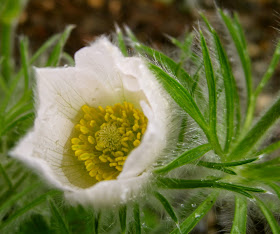Anyway, I managed to cut back and tidy all the dead foliage, and pull most of the weeds and pick up most of the debris left from our winter storms in the bottle tree bed.
On March 30, at the end of the day it looked like this.
 |
| Bottle Tree Bed, March 2014 |
Compare that to how it looked at the end of February, in last month's EOMV post, which you can read here.
 |
| Bottle Tree Bed in February, 2014 |
 |
| Tidy clumps of perennials |
 |
| Mukdenia rossii 'Kurasuba' looking good, but slated to be moved to a new spot about 15 feet away in the same bed |
 |
| A much tidier Invincibelle Spirit Hydrangea with last year's old flower heads finally trimmed off |
Emerging peonies are probably too far along for transplant, but I'm taking a shot at it anyway. They'll survive, although it's possible they might not bloom.
 |
| Peonies that were just nosing their way out of the soil at the end of February are quite far along now. |
 |
| By the end of the day on March 31, compost spread, Hydrangea and Mukdenia both moved, and Hellebore on the right has been dug and will be moved to that hole to the left of the Mukdenia |
 |
| Various Verbascum phaeum grown from seed |
 |
| Sheffield Pink mums and Agastache 'Golden Jubilee' dug and waiting |
 |
| Hardy Geranium waiting to be divided and planted on either side of the Mukdenia, also four pots full of rocks unearthed while digging. |
I've also started planting some of the perennials that I bought last year in anticipation of this project. I originally planned to do this bed renovation last fall, and collected plants all summer for that purpose. But my back had other plans, so I ended up putting it off till now. This morning I finally pulled all those plants out of my pot ghetto for an inspection. There were a couple that either didn't survive the winter in their pots, or are late risers. I haven't tossed them yet, I'll be keeping an eye on them for a bit.
Here's a list of what definitely survived:
Lamium orvala 'Silva'
Anemanthele lessoniana
Actaea 'Hillside Black Beauty'
Carex 'Banana Boat'
Amsonia hubrichtii
Paeonia ludlowii
Verbascum 'Clementine'
I have a plan for everything. The weather should be nice tomorrow too, which means that I'll be out there again hard at work. Check back when I do my End of the Month View post for April to see how it turns out.















































